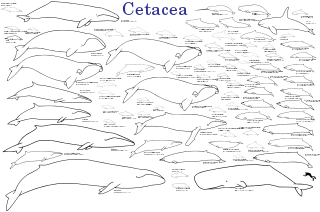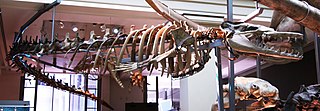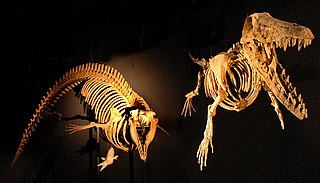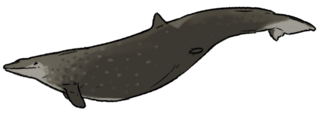
Rodhocetus is an extinct genus of protocetid early whale known from the Lutetian of Pakistan. The best-known protocetid, Rodhocetus is known from two partial skeletons that taken together give a complete image of an Eocene whale that had short limbs with long hands and feet that were probably webbed and a sacrum that was immobile with four partially fused sacral vertebrae. It is one of several extinct whale genera that possess land mammal characteristics, thus demonstrating the evolutionary transition from land to sea.

The evolution of cetaceans is thought to have begun in the Indian subcontinent from even-toed ungulates (Artiodactyla) 50 million years ago (mya) and to have proceeded over a period of at least 15 million years. Cetaceans are fully aquatic mammals belonging to the order Artiodactyla and branched off from other artiodactyls around 50 mya. Cetaceans are thought to have evolved during the Eocene, the second epoch of the present-extending Cenozoic Era. Molecular and morphological analyses suggest Cetacea share a relatively recent closest common ancestor with hippopotami and that they are sister groups. Being mammals, they surface to breathe air; they have five finger bones (even-toed) in their fins; they nurse their young; and, despite their fully aquatic life style, they retain many skeletal features from their terrestrial ancestors. Research conducted in the late 1970s in Pakistan revealed several stages in the transition of cetaceans from land to sea.

Ambulocetus is a genus of early amphibious cetacean from the Kuldana Formation in Pakistan, roughly 48 or 47 million years ago during the Early Eocene (Lutetian). It contains one species, Ambulocetus natans, known solely from a near-complete skeleton. Ambulocetus is among the best-studied of Eocene cetaceans, and serves as an instrumental find in the study of cetacean evolution and their transition from land to sea, as it was the first cetacean discovered to preserve a suite of adaptations consistent with an amphibious lifestyle. Ambulocetus is classified in the group Archaeoceti—the ancient forerunners of modern cetaceans whose members span the transition from land to sea—and in the family Ambulocetidae, which includes Himalayacetus and Gandakasia.

Basilosaurus is a genus of large, predatory, prehistoric archaeocete whale from the late Eocene, approximately 41.3 to 33.9 million years ago (mya). First described in 1834, it was the first archaeocete and prehistoric whale known to science. Fossils attributed to the type species B. cetoides were discovered in the United States. They were originally thought to be of a giant reptile, hence the suffix "-saurus", Ancient Greek for "lizard". The animal was later found to be an early marine mammal, prompting attempts at renaming the creature, which failed as the rules of zoological nomenclature dictate using the original name given. Fossils were later found of the second species, B. isis, in 1904 in Egypt, Western Sahara, Morocco, Jordan, Tunisia, and Pakistan. Fossils have also been unearthed in the southeastern United States and Peru.

Basilosauridae is a family of extinct cetaceans. They lived during the middle to the early late Eocene and are known from all continents, including Antarctica. They were probably the first fully aquatic cetaceans. The group is noted to be a paraphyletic assemblage of stem group whales from which the monophyletic Neoceti are derived.

Archaeoceti, or Zeuglodontes in older literature, is a paraphyletic group of primitive cetaceans that lived from the Early Eocene to the late Oligocene. Representing the earliest cetacean radiation, they include the initial amphibious stages in cetacean evolution, thus are the ancestors of both modern cetacean suborders, Mysticeti and Odontoceti. This initial diversification occurred in the shallow waters that separated India and Asia 53 to 45 mya, resulting in some 30 species adapted to a fully oceanic life. Echolocation and filter-feeding evolved during a second radiation 36 to 35 mya.

Zygorhiza ("Yoke-Root") is an extinct genus of basilosaurid early whale known from the Late Eocene of Louisiana, Alabama, and Mississippi, United States, and the Bartonian to the late Eocene of New Zealand . Specimens reported from Europe are considered Dorudontinae incertae sedis.
Pachycetus is an extinct genus of pachycetine basilosaurid from Middle Eocene of the eastern United States and Europe. The best known remains generally suggest that Pachycetus lived during the Bartonian, however, fossil finds have also been recovered from sediments of less certain age that could suggest that it may have also lived during the Late Lutetian and Early Priabonian. Pachycetus is primarily known from vertebrae and ribs and is characterized by its highly osteosclerotic and pachyostotic skeleton. This means the bones not only featured thickened rings of cortical bone surrounding the internal cancellous bone, but the cortical bone was furthermore much denser than in other basilosaurids. Two species of Pachycetus are recognized: Pachycetus paulsonii from Europe and Pachycetus wardii from the United States. A third species might be represented by "Zeuglodon" wanklyni.

Cynthiacetus is an extinct genus of basilosaurid early whale that lived during the Late Eocene Specimens have been found in the southeastern United States and Peru.

Remingtonocetidae is a diverse family of early aquatic mammals of the order Cetacea. The family is named after paleocetologist Remington Kellogg.
Gaviacetus is an extinct archaeocete whale that lived approximately 45 million years ago. Gaviacetus was named for its characteristic narrow rostrum and the fast pursuit predation suggested by its unfused sacral vertebrae.
Basiloterus is an extinct genus of late-Eocene archaeocete whale from the Drazinda Formation in southwestern Punjab, Pakistan and possibly also the Barton Group of England. Known from two isolated lumbar vertebrae, the elongated nature of these elements has been taken as possible evidence that Basiloterus was a close relative of the better-known Basilosaurus. This was also the reasoning behind its name, which roughly translates to "another king". However, publications since then not only lead to some major changes of the internal relationships within Basilosauridae but have also called into question how diagnostic elongated vertebrae are for members of this group, as other early whales have developed similar anatomy independently. Though the identity of Basiloterus as a basilosaurid is generally maintained, its exact position within more recent interpretations of the family is unclear.
Protocetidae, the protocetids, form a diverse and heterogeneous group of extinct cetaceans known from Asia, Europe, Africa, South America, and North America.
Pontogeneus is a genus of extinct cetacean known from fossils recovered from the Late Eocene sediments of the southeastern United States.

Supayacetus is an extinct genus of basilosaurid cetacean from the Middle Eocene Paracas Formation of Peru. It has been noted for its relatively small size and basal morphology, with the sternum bearing close resemblance to those of protocetids. Due to this, it has been traditionally placed as one of the basalmost basilosaurids, except for a 2023 study that places it within the family Pachycetinae close to Neoceti. Supayacetus is monotypic, meaning the genus includes only a single species: S. muizoni.
Babiacetus is an extinct genus of early cetacean that lived during the late Lutetian middle Eocene of India . It was named after its type locality, the Harudi Formation in the Babia Hills, Kutch District, Gujarat, India.
Carolinacetus is an extinct protocetid early whale found in the Bartonian Tupelo Bay Formation in Berkeley County, South Carolina.
Eocetus is an extinct protocetid early whale known from the early-late Eocene Giushi Formation in Gebel Mokattam, outside Cairo, Egypt. Fossil remains have also been discovered in the Aridal Formation of the Sahara Desert in southwestern Morocco.
Pachycetinae is an extinct subfamily of basilosaurid cetaceans that lived during the middle Eocene. The best-dated remains stem from Bartonian strata, but some finds suggest that they could have first appeared during the Lutetian and may have survived until the Priabonian. Fossils of pachycetines are chiefly known from the southern United States, Ukraine, Morocco and Germany, among others. They differ from other basilosaurids in having pachyostotic and osteosclerotic vertebrae and ribs, making them denser and heavier by comparison. Based on this it has been suggested that these whales lived in shallow waters and that these thickened bones act as a buoyancy control as seen in sirenians. Analysis of the teeth suggests that pachycetines had a varying diet, with the robust teeth of the larger Pachycetus indicating that it possibly fed on sharks, whereas the more gracile teeth of Antaecetus suggest a diet of smaller prey items. The clade currently only includes two genera, Antaecetus and Pachycetus, but a 2023 study suggests that the Peruvian Supayacetus may at least be a close relative.

Antaecetus is an extinct genus of pachycetine basilosaurid from the middle Eocene Aridal Formation of Morocco as well as the Fayum, Egypt. Antaecetus, although known from fewer remains in total, is markedly more complete than the closely related Pachycetus, with one specimen preserving large parts of the vertebral column up to the lumbar vertebrae and a well preserved skull. Based on these remains Antaecetus appears to have been smaller than Pachycetus, with a proportionally smaller head and much more gracile teeth. Both genera however share a highly osteosclerotic and pachyostotic skeleton, greatly increasing their weight and possibly serving as additional ballast. In turn the elongation and thickening of the vertebrae severely impacts the animals movement, most likely causing it to have been much slower and far less mobile than other archaeocetes. It has been proposed that Antaecetus was a slow moving inhabitant of shallow coastal waters, where it would ambush fish and marine molluscs. Only a single species of Antaecetus is known, Antaecetus aithai, which was originally described as a species of Pachycetus.












